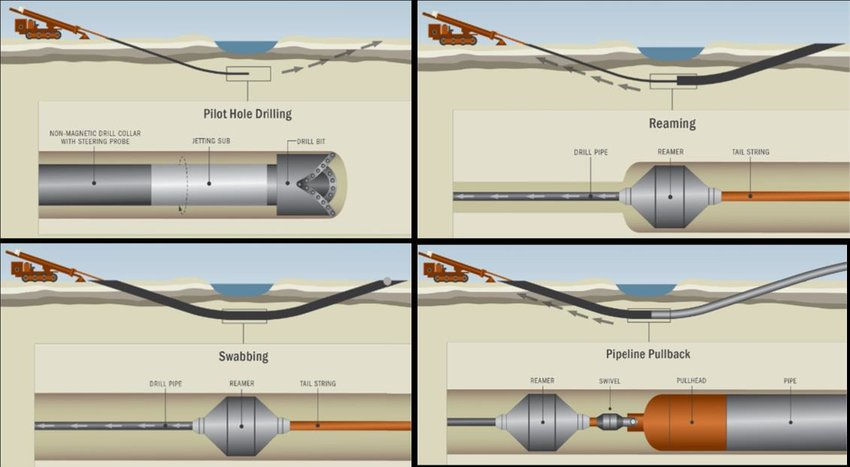Top 5 Innovative Technology Utilized in Underground Boring Services
- Grid Tech
- Jun 15, 2023
- 4 min read
Underground boring technology has come a long way in revolutionizing the construction and utility industries. In recent days, the world of underground boring services has experienced a remarkable transformation. And the credit goes to the ground-breaking innovative technology. With advancements in equipment and techniques, excavations have become more efficient, cost-effective, and environmentally friendly than ever before.
Today, in this blog, we will explore the top five innovations that have significantly impacted the underground boring landscape. From improved drilling methods to cutting-edge guidance systems, these innovations are transforming the way underground projects are executed, bringing new possibilities and advantages to the table.
So, let’s join us as we embark on a journey to discover the cutting-edge technologies that are paving the way for efficient, sustainable and cost-effective underground boring services.

Directional Drilling with Precision Guidance Systems:
One of the most amazing innovations in underground boring service technology is the development of directional drilling combined with precision guidance systems. Traditional drilling process frequently required extensive digging, which causes inconvenience and disturbed the surrounding environment.
However, with direction drilling technology, contractors can now drill underground at different angles, avoiding obstacles and reducing the need for surface disruptions. The introduction of precision guidance systems further enhances this process, allowing operators to monitor and adjust the drilling path in real-time. This not only improves accuracy but also minimizes the risk of hitting existing utilities, ensuring safety and preventing costly damages.
Augmented Reality Visualization for Subsurface Mapping:
Augmented reality or AR has found its way into underground boring services. It enables contractors to visualize and map subsurface structures more effectively. AR visualization tools utilize 3D models and overlays to provide a clear representation of underground utilities and potential obstacles. By superimposing these virtual elements onto the real environment, contractors can plan their underground drilling paths with greater precision. And most importantly, it reduces the chances of errors or clashes. This technology enhances efficiency, allowing operators to make informed decisions and avoid unnecessary delays caused by unexpected subsurface surprises.

Horizontal Directional Drilling for Longer Distances:
Horizontal Directional Drilling or HDD is a ground-breaking method used in underground boring services. This technology has enabled the installation of utilities over long distances without the requirement for continuous trenching. Unlike traditional excavation methods that involve digging trenches, HDD allows for drilling underground horizontally, beneath obstacles such as roads, rivers and existing building structures.
The HDD process begins with a specialized drilling rig that creates a pilot hole along the desired path. The drill bit is guided by a combination of surveying instruments and guidance systems, ensuring accurate alignment. Once the pilot hole is completed, the diameter of the hole is gradually increased through reaming to accommodate the utility, such as pipelines or conduits.
This technology offers several significant advantages. Firstly, it minimizes surface disruptions and reduces the need for extensive restoration work, thereby minimizing inconvenience and cost. And secondly, it reduces environmental impact by avoiding disturbance to sensitive areas and preserving natural habitats. Additionally, HDD is a safer method as it minimizes the risk of accidental utility strikes and ensures the integrity of existing infrastructure.
So, as a versatile and efficient technique, HDD has become an indispensable solution for various projects, including urban infrastructure development, oil and gas pipelines and telecommunications installations. Its ability to enable long-distance installations with minimal disruptions has made HDD a preferred choice in the field of underground boring services.
Micro tunneling:
Micro tunneling is a cutting-edge technology that enables precise and minimally invasive excavations. This method involves the use of remotely controlled machines, known as Micro-tunnel Boring Machines (MTBMs), to construct tunnels with diameters ranging from a few inches to several feet. With the ability to operate under high groundwater pressure and in challenging soil conditions, Micro tunneling has gained a lot of popularity as an efficient and sustainable underground boring technique.
Improved Fiber Optic Monitoring Systems:
Fiber optic monitoring systems have emerged as a significant innovation in underground boring service technology. These systems utilize fiber optic cables installed alongside underground infrastructure to monitor and detect potential structural changes, such as shifts or leaks. By continuously monitoring these parameters, contractors can identify issues before they escalate, allowing for timely maintenance and repair.
This proactive approach not only enhances the lifespan of underground utilities but also improves the overall safety and reliability of the infrastructure. With advancements in sensor technology and data analytics, fiber optic monitoring systems are becoming more sophisticated, providing real-time insights and enabling predictive maintenance.

Final Thoughts
In conclusion, these above-mentioned top five innovative technologies in underground boring service have ushered in a new era of efficiency, precision and sustainability. The advancements in directional drilling with precision guidance systems have revolutionized the way excavations are carried out, minimizing surface disruptions and ensuring safety. Augmented reality visualization has provided contractors with powerful tools for subsurface mapping, enabling informed decision-making and reducing delays caused by unforeseen obstacles. Horizontal Directional Drilling has unlocked the potential for long-distance installations without continuous trenching, offering cost-effective and environmentally-friendly solutions. Micro tunneling has emerged as a precise and minimally invasive method, ideal for projects that demand accurate tunneling. Improved fiber optic monitoring systems have enhanced the safety and longevity of underground infrastructure through real-time insights and predictive maintenance. These innovations collectively showcase the remarkable progress in underground boring services. They are paving the way for a future where excavations are executed with unparalleled efficiency and minimal impact on the environment.

Comments